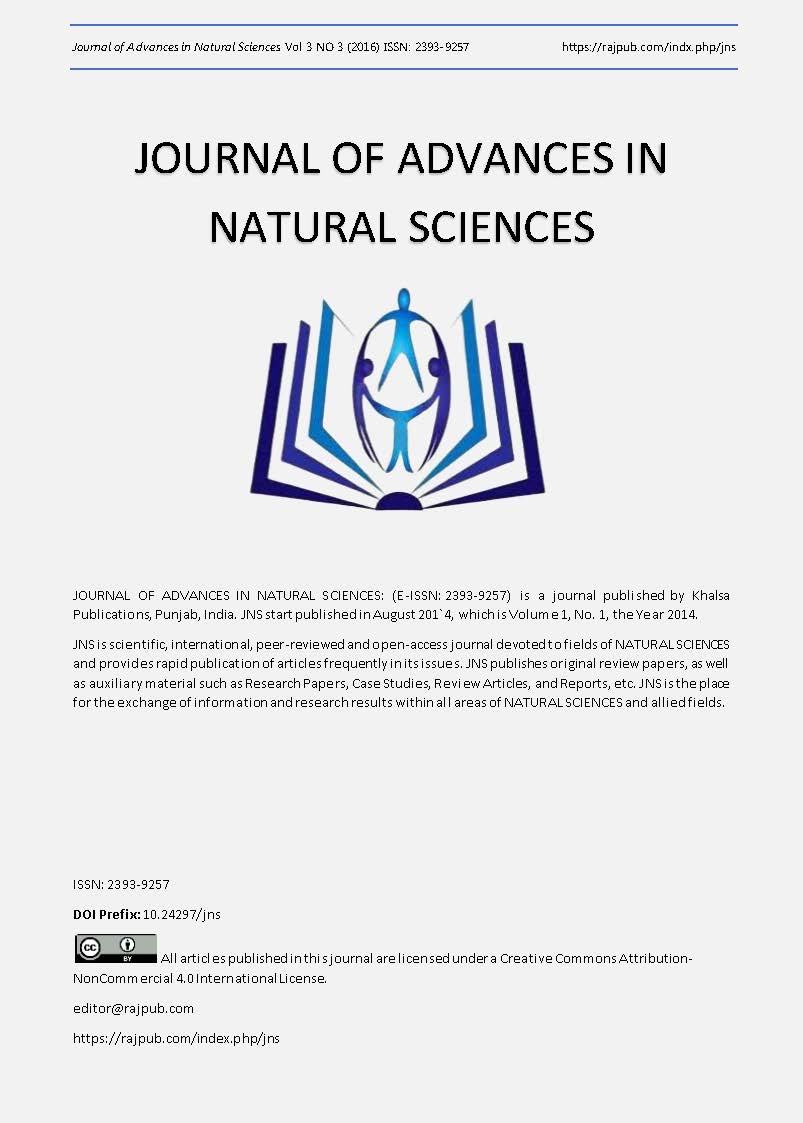QUALITATIVE & QUANTITATIVE PHYTOCHEMICAL SCREENING AND PROXIMATE COMPOSITION OF BOMBAX BUONOPOZENSE (RED SILK COTTON TREE) STEM-BACK
DOI:
https://doi.org/10.24297/jns.v3i3.3970Keywords:
phytochemical screening, proximate composition, Bombax buonopozense, quantitative / qualitative analysis, stem-backAbstract
Qualitative & quantitative phytochemical screening and proximate composition of Bombax buonopozense stem was investigated. Nine phytochemicals viz: - alkaloid, carbohydrate, phenols, flavonoids, saponins, tannins, protein, terpenoids, and oxalates were observed. Steroids and glycosides were below detectable limits. Quantitative phytochemical analysis indicated that alkaloid, flavonoid, phenols, tannins and saponins had values of 0.68 g, 0.09 g, 2.35 g, 1.41 g and 1.15 g respectively. The proximate analysis gave high percentage moisture content (55.30%). Carbohydrate and protein were of low values (1.04 % and 6.0% respectively). Ash content was found to be 15.30%, fiber (16.80%)All analyses wereper100g of crude sample.
Downloads
References
2. HarboneJ.B. (1973): Phytochemical methods.Chapmanand Hall Ltd, London 1973; 279.
3. OkwuD.E. (2004): Phytochemicals and Vitamin content of indigenous spices of South Eastern Nigeria. Journal of sustenance of AfricaEnvironment;6:30-34.
4. E. E. Bassey, M.E. Khan (2015): Proximate Composition and Phytochemical Analysis of bombax buonopozense leaves (Gold Coast Bombax). Int. J. Curr. Res. Chem. Pharma. Sci. 2(11): (2015): 51–56
5. Iroka Finian Chisom,Okereke Chukwu N, Okeke C. U. (2014): Comparative phytochemical and proximate analyses on Ceiba pentandra (L) Gaertn. And Bombax buonopozense (P) Beauv.:InternationalJournal of Herbal Medicine 2014; 2(2): 162-167
6. Vijyalakshmi R, Ravindran R. : Preliminary comparative phytochemical screening of root extracts of Diospyrus ferrea(Wild.) Bakh and Arva lanata (L.) Juss. Ex Schultes. Asian J PlantSci Res 2012; 2:581-587.
7. C. U. Inyang, and A. A. Adegoke (2008): Antimicrobial Properties and Phytochemical Screening of Chromoleana odorata (Siam or Sapysa weed) leaf. Nig. Jorn. Of Microbiology, vol. 22(1): 1652-1659
8. Beentje .H, Smith S. (2001): Plant systematic andPhytogeography for the understanding of African Biodiversity. Systematic and Geography of plants;71(2):234-286.
9. Germplasm Resources Information Network (2007)(GRIN"Bombax" http://www.ars-grin.gov.
10. Edeoga H. O, Okwu DE, Mbaebei BO (2006). Phytochemicalconstituents of some Nigerian Medicinal plants. Afr. J. Biot. 4(7):685-688.
11. Temitope Israel Borokini, Felix Oluwafemi Omotayo(2012): Phytochemical and ethnobotanical study of some selected medicinal plants from Nigeria; Journal of Medicinal Plants Research Vol. 6(7), pp.1106-1118, 23 February,2012.
12. AOAC (2000). Association of Official Analytical Chemists. 18thedition. official methods of analysis.Washington dc: pp.18-62
13. Trease G.E, Evans W.C (1989): Textbook ofPharmacognosy. W.B. Sanders, London.14Edition.
14. Sofowora A. (1993): Medicinal plants and traditionmedicine in African. Spectrum Books Ltd, IbadanNigeria, 2 ndEdition, 1993,289.
15. Bolim j.m “Nutritional and chemical evaluation of Momordica charantia”, Journal of Medicinal Plants Research. 1994, Vol. 4(21), 2189-2193.
16. Ubadoni ochuko,Adoum, O.A., Akinniyi, J.A. and Omar, T. (2001): The effect of geographical location on the antimicrobial activities and trace element concentration in the root of Calotropis procera (Ait.) R. Br. Annals of Borno 13(14) :199-207.
17. Adeyemi S. A, J. E. Ehiagbonare, and S. C. O. Nwangwu, “Nutritional evaluation of some staple leafy vegetables in Southern Nigeria”, International Journal of Agricultural and Food Science. 2012, Vol. 2(2), 37-43.
18. Olujobi Wasagu (2015): Evaluation of phytochemical and anti-oxidant levels and antimicrobial screening of aqueous leaf extract of Aloe vera (Aloe barbadensis MILLER). Biological and Environmental Sciences Journal for the Tropics 2(2) :21-25.
19. Atamgba Agbor Asuk, Margaret Akpana Agiang, Kayode Dasofunjo, Amonor James Willie (2015): The biomedical significance of the phytochemical, proximate and mineral compositions of the leaf, stem bark and root of Jatropha curcas. Asian Pacific Journal of Tropical Biomedicine.Asian Pac J Trop Biomed 2015; 5(8): 650–657
20. Stray F. (1998): The National Guide to MedicinalHerbs and Plants. Tiger Books InternationalLondon, 1998, 72.
21. Salah W, Miller N.J, Pagauga G., Tijburg G, Bonel A.P, Rice E, Evans C. (1995): Polyphenolic flavonoids as scavengers of aqueous phase radicals as chain breaking oxidant. Arch BiochemBioech 1995; 2:339346.
22. Nakayoma J, Yamada M. (1995): Suppression of active oxygen-indeed cyto toxicity by flavonoids. Biochem. Pharmcol., 45: 265-267.
23. Dathak P, Iwu M (1991): Inhibition of Xanthine oxidaseactivity by some flavonoids. Phytother., 63: 385.
24. Negi JS, Singh P, Rawat B. (2011): Chemical constituents and biologicalimportance of Swertia: a review. Curr Res Chem 2011; 3:1-15.
25. Okeke C.U, Elekwa I. (2009): Proximate andPreliminary Photochemical Analyses of Avocado Pea Persea gratissima Cacrtn. F. (Family Lauracea). Nigeria Journal of Botany; 9(1):159162.
26. Okwu DE, Ekeke O. (2003): Phytochemical Screening and Mineral Composition of Chewingsticks in South Eastern Nigeria. Global journal pure and applied science 2003;9:235-238
27. Eyong M. Andzouana (2011): “Assessment of the chemical and phytochemical constituents of the leaves of a wild vegetable - Ochthocharis dicellandroides (Gilg)”, Pakistan Journal of Nutrition. 2011, Vol. 11(1), 94-99.
28. Dubrovsky B.O. (2005): Steroids, Neuroactive steroids in psychopathology. Progress in Neuropsychopharmacology and Biological Psychiatry; 29:169-192
29. Ukana D. Akpabio, Uwemedimo E. Udo and Aniekan E. Akpakpan. (2012): Evaluation of phytochemical, proximate and mineral element composition of stem of Costus afer (Bush cane). Asian Journal of Plant Science and Research, 2012, 2 (5):607-612
30. Stray F. (1998): The National Guide to Medicinal Herbs and Plants.Tiger Books International London, 1998, 72.
31. Kar,A.(2007).PharmaocgnosyandPharmacobiotechnology. NewAgeInternationalLimted PublishresNewDelhi.(Revised-ExpandedSecondEdition) pp332-600
Downloads
Published
How to Cite
Issue
Section
License
 All articles published in Journal of Advances in Linguistics are licensed under a Creative Commons Attribution 4.0 International License.
All articles published in Journal of Advances in Linguistics are licensed under a Creative Commons Attribution 4.0 International License.




